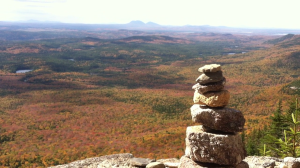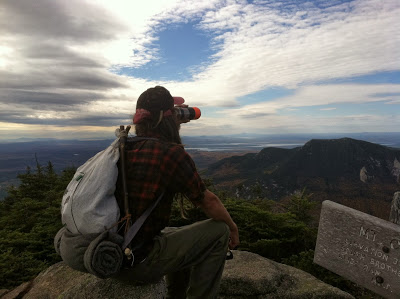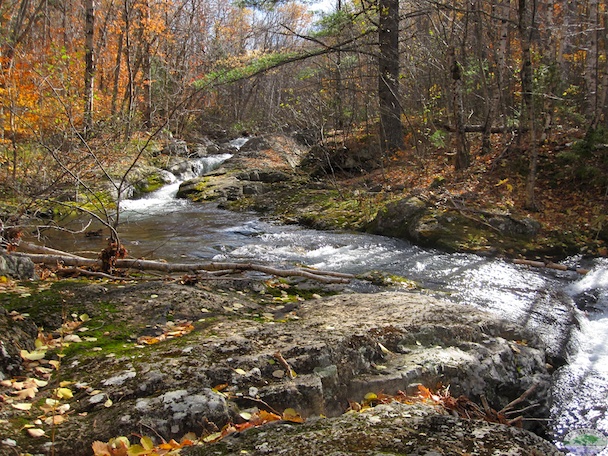 I just got back to the Jack Mountain Field School from a great day hike in Baxter State Park in Maine. We arrived around 10 am (a few hours later than we’d planned, gotta have coffee right?) to find the parking lots servicing the three trails that wind up to the peak of Katahdin full for the day. Full? The ranger at the toll booth proceeded to give us the skinny on the park’s rules regarding access to the top of the highest point in Maine: in order to limit traffic and thereby reduce wear and tear on the trails and the alpine ecosystem crowning the massive hunk of rock, the park has a limit on how many cars can park at each of the parking lots. While this all seemed to make sense, it did honestly, we still spent the next half an hour, ok maybe the next hour, bitching about the policy and trying to figure out a way to sneak past the rangers. What puts the bite in the ranger’s bark is not only a hefty $200 fine if you are caught parking at a parking lot other than the one the tag in your windshield assigns you to, but also, if you are of the scandalous type and try to park in another parking lot and walk the road to a Katahdin trail (the most common way people circumvent the system) on the 1 day in 14 or so when they also send in a tow truck, you may end up with a boot on one of your car’s tires, and a $200 fine.
I just got back to the Jack Mountain Field School from a great day hike in Baxter State Park in Maine. We arrived around 10 am (a few hours later than we’d planned, gotta have coffee right?) to find the parking lots servicing the three trails that wind up to the peak of Katahdin full for the day. Full? The ranger at the toll booth proceeded to give us the skinny on the park’s rules regarding access to the top of the highest point in Maine: in order to limit traffic and thereby reduce wear and tear on the trails and the alpine ecosystem crowning the massive hunk of rock, the park has a limit on how many cars can park at each of the parking lots. While this all seemed to make sense, it did honestly, we still spent the next half an hour, ok maybe the next hour, bitching about the policy and trying to figure out a way to sneak past the rangers. What puts the bite in the ranger’s bark is not only a hefty $200 fine if you are caught parking at a parking lot other than the one the tag in your windshield assigns you to, but also, if you are of the scandalous type and try to park in another parking lot and walk the road to a Katahdin trail (the most common way people circumvent the system) on the 1 day in 14 or so when they also send in a tow truck, you may end up with a boot on one of your car’s tires, and a $200 fine.

We were left a bit peeved by the bureaucratic tangle that was keeping us from Katahdin, which was our second failed attempt in three weeks- remember a sharp axe will have no reservations about splitting wood, tennis shoes, socks and eventually toes. To be fair, the ranger felt our disappointment and was happy to give us suggestions, although oddly not a map, about where we could go and still get in a good hike. Instead of testing our resolve to hike the big peak, we settled on a string of smaller climbs starting with OJI and finishing at North Brother. The 12 or so mile loop, which would have been 15 if it were not for a clutch ride back to our car, was great, and since we passed maybe 9 people all day on a balmy Saturday in early October, the wisdom of the park’s plan to limit access to the trails was obvious. But this isn’t just another trail review.
I am always on the lookout for new places to try out the sustainable camping gear I have been making, tinkering with and using for years. For this day trip I took a #10 coffee can cook stove, a wool blanket, some munchies and water, and carried it all in an old seed bag attached to a 3-stick framepack (a Roycroft frame pack for those in the know) with the whole shootin’ match tied to me with an old strip of webbing from a boat trailer winch. The beauty of the pack is that the whole thing was locally made, made of either renewable local natural materials or from upcycled industrial materials, and was absolutely free. These frame packs are comfortable to wear, can hold all kinds of gear either in a bag attached to the frame or by lashing gear onto the frame directly, and make your kit unique from every other cookie cutter skittle colored outfit on trail.
The nice folks who gave us a lift to our car had been hiking in a similar cadence to us all day, so we had passed each other frequently and had the obligatory “you’re almost there” or “beautiful day, huh?” trail chats. When we reached the parking lot, one of the other campers said something to the tune of “Yeah, we saw your pack and thought wow, he is way more sustainable than we are.” That was hallelujah moment for this hiker as usually I just get called cheap, poor, or podunk because of my homemade gear. The great part of the comment was that the group was an older trip leader and a few younger hikers, and since what monkey sees monkey does, I felt good knowing those youngins’ saw my gear in a positive light. The images and ideas that we seasoned trail hounds provide for the next generation of backcountry junkies will become their ethic as well someday, so we need to be sure that the images we are putting out there represent an ecologically conscious and responsible one.
Of course, a hiker or an army for that matter, marches on its stomach. To replace the old gas burning cook stoves, I brought along a little #10 coffee can hobo stove. These little rocket stoves are dramatically lighter than gas and a gas stove, easy to use, and burn efficiently. The one in the picture took maybe 30 minutes to make, will burn anything from twigs to turds and will boil my little billy can full of water in under 10 minutes. Maybe next we should pit the two side by side to see which one will boil water faster…









